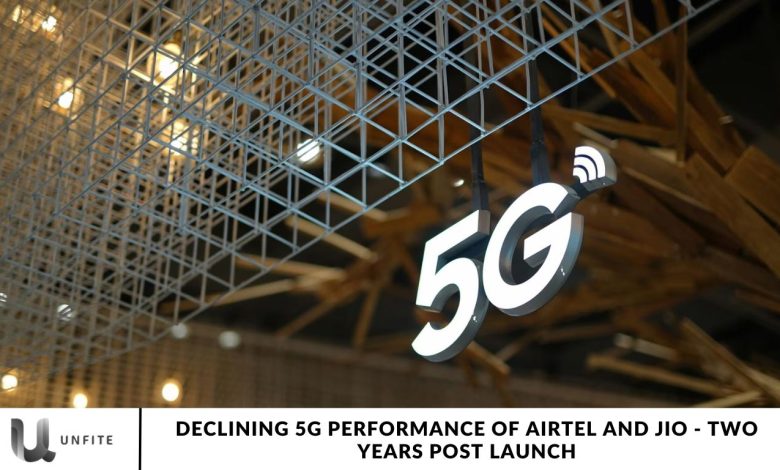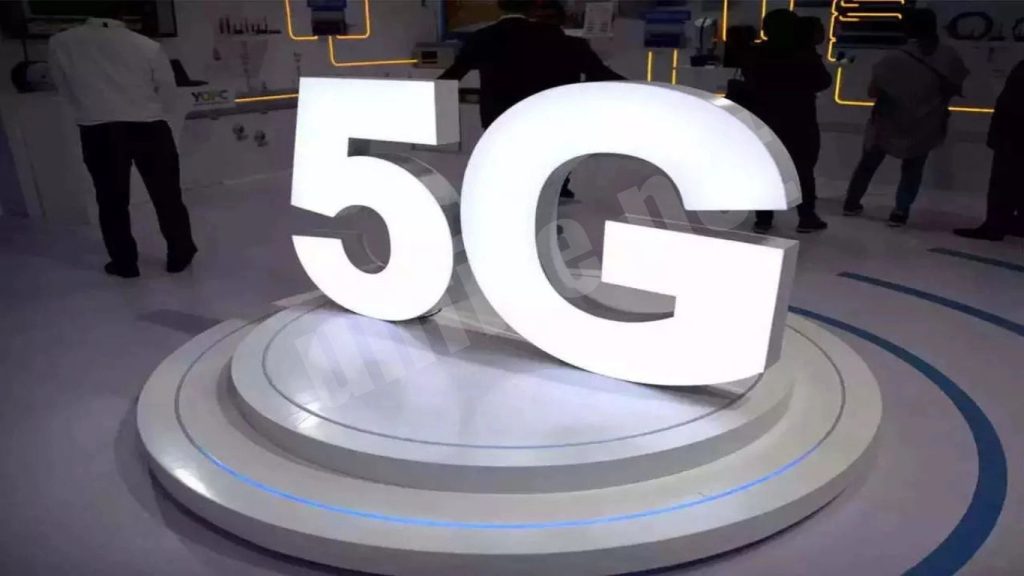Declining 5G Performance of Airtel and Jio – Two Years Post Launch

India’s telecommunications sector 📡 is booming alongside developed nations 🌍, thanks to leading giants like Reliance Jio and Airtel 🚀. But amid the growing 5G wave 🌐, a recent report by Opensignal 📊 reveals a drop in 5G performance for Airtel and Jio two years after launch 📉, causing some concern in the industry.
We’ll take a detailed look 🔍 at the current 5G performance in India, exploring the recent Opensignal report 📊 that reveals a decline in Airtel and Jio’s 5G speeds 📉 two years after launch.
What is 5G and 5G Promised?
In the telecom world 🌐, 5G—our fifth generation of cellular tech—launched globally in 2019, succeeding 4G and connecting most modern devices 📱.
Promising lightning-fast speeds 🚀, lower latency, and multi-device connectivity, 5G generated colossal excitement, driving significant infrastructure investments by companies to ensure seamless service. Many users eagerly upgraded their devices 🔄 to tap into the benefits of this advanced network.
Why Does Performance Decline?
There are multiple reasons 📉 behind the drop in Airtel and Jio’s 5G performance two years after launch that consumers should know about. Here are the main factors contributing to this decline: 👇
Network Congestion 🚦
As the 5G user base expanded, networks became overloaded. The existing infrastructure, designed for lower traffic, is now struggling to keep up with skyrocketing demand, resulting in a decline in service quality.
Limited Spectrum Availability 📡
Access to spectrum is essential for delivering high-speed services. Currently, both Airtel and Jio are facing limited spectrum allocations, which obstructs their ability to maintain consistent speeds.
Infrastructure Challenges 🏗️
Despite significant investments, the rollout of necessary infrastructure—like small cells and backhaul connections—has not kept pace with demand. In many urban areas, the existing infrastructure struggles to support the surge in data traffic.
User Expectations vs. Reality 😟
Early promotional efforts set user expectations extremely high. When users compare their actual experiences to the promised features, dissatisfaction is likely significantly higher when connectivity issues disrupt essential activities like video streaming or gaming.
Impact on Users 🌍
The decline in Airtel and Jio’s 5G performance two years after launch is not just a technical concern; it has real-world implications for users. Many consumers who upgraded their devices for 5G are feeling let down, as they aren’t receiving the service they anticipated. This dissatisfaction may drive users to switch providers or revert to 4G plans.
Understanding the 5G Landscape in India

Overview of 5G Technology and Its Significance
5G technology, the fifth generation of mobile networks 📶, marks a significant leap forward from its predecessor, 4G. It is designed to provide dramatically faster data speeds 🚀, lower latency ⏱️, and the ability to connect a larger number of devices simultaneously. With speeds up to 100 times faster than 4G, 5G enables real-time communication and supports innovative applications like augmented reality (AR) 🕶️, virtual reality (VR) 🌌, and the Internet of Things (IoT) 🌐. This technology is essential for enhancing user experiences across various sectors, including healthcare 🏥, transportation 🚗, and entertainment 🎮, allowing for seamless connectivity and improved efficiency.
The significance of 5G extends beyond faster internet speeds; it is set to revolutionize industries by enabling smart cities 🏙️, autonomous vehicles 🚘, and advanced manufacturing processes 🏭. The ability to handle massive data traffic with minimal delay opens new avenues for technological advancements, making 5G a critical infrastructure for future digital ecosystems.
Quick Recap of the Initial Expectations Set by Airtel and Jio
When Airtel and Jio launched their 5G services 📡, they generated considerable excitement among consumers and industry stakeholders. Both companies promised high-speed internet connectivity, significantly reduced latency, and the ability to connect multiple devices simultaneously without sacrificing service quality. Marketing campaigns emphasized the potential of 5G to enhance everyday activities, from seamless streaming of high-definition content 📺 to instantaneous downloads and smoother gaming experiences 🎮.
Moreover, Airtel and Jio projected 5G as a transformative force for various sectors, showcasing its potential to drive innovation in healthcare, education 🎓, and intelligent infrastructure 🏗️. As a result, consumers were eager to upgrade their devices 🔄 to fully embrace the next-generation network, anticipating a dramatic improvement in their mobile experience. The high expectations set by these telecom giants positioned 5G as a pivotal development in India’s technological landscape.
Factors Contributing to Declining Performance
Network Congestion 🚦
The increase in the user base for 5G services has significantly strained network performance. As more consumers adopt 5G technology, the volume of data traffic has surged, leading to network congestion. This saturation occurs when too many users attempt to access the network simultaneously, resulting in slower speeds and dropped connections.
Recent statistics indicate that mobile data traffic has skyrocketed, with projections showing that global mobile data traffic will reach over 77 exabytes per month by 2025—an increase of nearly 300% compared to 2020 📈. In India, specifically, Airtel and Jio have reported traffic growth rates of 50% year-over-year, highlighting the urgent need for infrastructure improvements to accommodate this rising demand 📊.
Limited Spectrum Availability 📡
Spectrum availability is crucial for delivering high-speed connectivity, as it determines how much data can be transmitted over the network at any given time. The more spectrum a provider has, the better the performance and coverage they can offer. Currently, both Airtel and Jio are grappling with limited spectrum allocations, which hampers their ability to maintain consistent speeds ⚡.
Both companies face challenges in acquiring additional spectrum through government auctions, leading to insufficient bandwidth to meet user demands. As a result, users often experience slower speeds and interrupted service, particularly during peak usage times, further exacerbating dissatisfaction among customers 😩.
Infrastructure Challenges 🏗️
Both Airtel and Jio have made significant investments in their 5G infrastructure, with billions of dollars allocated to upgrade their networks and enhance service quality 💰. These investments include deploying small cells, expanding fiber optic networks, and improving backhaul connections to support increased data traffic.
However, the rollout of this necessary infrastructure has not kept pace with the growing demand. In many urban areas, the existing infrastructure struggles to support the surge in data traffic, leading to bottlenecks that degrade overall service quality 🚧. Despite the companies’ efforts, many users in densely populated regions still face connectivity issues, highlighting the urgent need for more robust infrastructure development 🏙️.
User Expectations vs. Reality 😟
When Airtel and Jio launched their 5G services, they set high expectations for users, promising unparalleled speed and connectivity 🌟. However, the reality has not always matched these lofty promises. Users often find themselves experiencing slower speeds, dropped connections, and inconsistent service quality compared to what was advertised.
Feedback from users indicates a growing sense of disappointment, particularly among those who upgraded their devices specifically for 5G connectivity 📱. Satisfaction levels have dipped, with many consumers voicing concerns about the gap between the promised features and their actual experiences. A recent survey showed that nearly 60% of 5G users felt that the service did not meet their expectations, especially regarding streaming and online gaming experiences 🎮. This disconnect between expectations and reality has led to increased scrutiny of both companies’ capabilities and their commitment to delivering on their promises.
5G Network Speeds Decline

According to a report by independent analytics firm OpenSignal, both Airtel and Reliance Jio have experienced a significant decline in 5G network speeds 📉. This decline is attributed to network congestion, which has arisen from the rapid adoption of 5G and increased data consumption per subscriber 📊.
The analysis indicates that only 16% of 5G connections in India utilize the low-band (700MHz) spectrum. While this spectrum offers more comprehensive coverage, it is limited in speed 🌐. In contrast, most connections use the mid-band 3.5GHz spectrum, which provides faster speeds but less coverage ⚡.
Airtel currently leads India’s 5G market in several categories, including download speeds, upload speeds, live video quality, video streaming, and gaming experience 🎮. The company employs a non-standalone access (NSA) approach, which layers 5G technology over the existing 4G infrastructure. This strategy facilitates a faster rollout of 5G in urban areas 🏙️. Additionally, Airtel is enhancing its 4G infrastructure by planning the installation of 300,000 new base stations over the next three years 🏗️.
While Reliance Jio lags behind Airtel in some performance categories, it has secured the Consistent Quality award, boasting a score of 66.5% 🌟. Users report having adequate speed for everyday tasks, such as uploading photos on social media and making video calls 📱. Jio also enjoys a 99.4% availability score, making it a leader in market availability across India 🇮🇳.
While both Airtel and Reliance Jio have successfully implemented their 5G strategies, competitors like Vodafone Idea (Vi) and BSNL are facing financial challenges that hinder their ability to launch 5G services commercially in India 💼.
Frequently Asked Question
What are the main reasons for the decline in 5G performance for Airtel and Jio?
The decline in performance is primarily due to network congestion, limited spectrum availability, infrastructure challenges, and a gap between user expectations and actual service experiences.
How has user adoption affected 5G network performance?
As more users adopt 5G services, network congestion has increased, leading to slower speeds and reduced service quality due to the existing infrastructure struggling to handle the higher traffic levels.
What spectrum bands are Airtel and Jio using for their 5G services?
Airtel and Jio utilize both low-band (700MHz) and mid-band (3.5GHz) spectrums. While the low band provides more comprehensive coverage but limits speed, the mid band offers higher speeds but less coverage.
How does Airtel’s approach to 5G differ from Jio’s?
Airtel employs a non-standalone access (NSA) approach, leveraging existing 4G infrastructure for quicker 5G rollout. At the same time, Jio has focused on building a more robust standalone network from the ground up.
What steps is Airtel taking to improve its 5G infrastructure?
Airtel plans to install 300,000 new base stations over the next three years to strengthen its 4G and 5G infrastructure, address capacity issues, and improve overall service quality.
How has user satisfaction changed since the launch of 5G services?
User satisfaction has decreased as many customers report experiencing speeds and connectivity that do not meet the high expectations set during the 5G rollout’s promotional phase.
What is the availability score of Jio’s 5G network compared to Airtel’s?
Jio boasts a 99.4% availability score, making it a leader in market availability in India, while Airtel has also maintained a strong presence but has not disclosed a specific availability score.
How do the 5G experiences of Airtel and Jio compare with competitors like Vodafone Idea and BSNL?
Airtel and Jio have advanced 5G strategies, whereas Vodafone Idea and BSNL are hindered by financial issues, affecting their ability to launch competitive 5G services in India.
What are users primarily using 5G for, and how has performance affected their experience?
Users primarily use 5G for high-demand applications like video streaming, online gaming, and video calls. Performance issues, such as slower speeds and connectivity drops, have negatively impacted these activities.
What future developments can we expect from Airtel and Jio regarding 5G services?
Both companies are expected to continue investing in infrastructure improvements and spectrum acquisition to enhance 5G performance, aiming to meet growing user demands and restore customer satisfaction.
Conclusion
The declining 5G performance of Airtel and Jio two years after their launch highlights significant challenges within India’s telecommunications landscape. While both companies initially generated excitement with promises of high-speed connectivity and enhanced user experiences, factors such as network congestion, limited spectrum availability, and infrastructure challenges have hindered their ability to deliver on these expectations.
As user adoption increases, the pressure on existing networks has become evident, leading to decreased satisfaction among subscribers who upgraded their devices in anticipation of superior service. While Airtel continues to lead in several performance categories and Jio maintains muscular availability, both must address the widening gap between consumer expectations and actual experiences.




